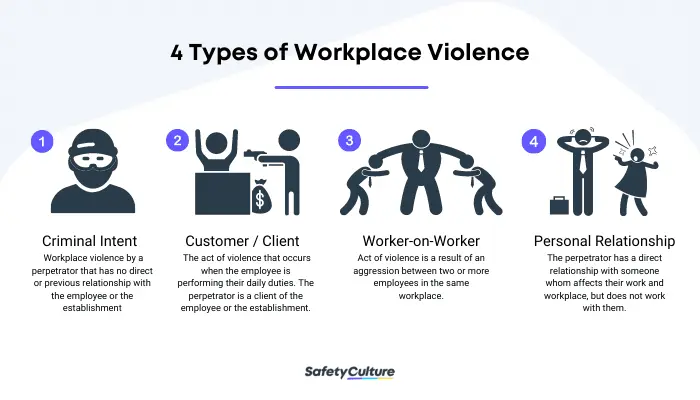What is Workplace Violence?
According to the Occupational Safety and Health Administration (OSHA), workplace violence is any act that hurts or threatens a person with physical violence, verbal abuse, intimidation, harassment, and other disruptive or harmful behavior during work or occurring at one’s workplace.
Types

4 Types of Workplace Violence
The National Institute for Occupational Safety and Health (NIOSH) of the United States classifies workplace violence into four types. Each category is defined by the relationship of the employee to the one harming them. The categories are as follows:
Type 1: Criminal Intent
Criminal intent workplace violence is when the employee or the establishment they work in has no direct or previous relationship with the perpetrator. This is common in the retail industry. The most common acts of violence associated with this type are theft, trespassing, breaking and entering, and assault.
Type 2: Customer/Client
For customer/client violence, the perpetrator is a client of the employee or the establishment. In this situation, the act of violence is often done when the employee is performing their daily duties. This type of violence is commonly seen in the healthcare, retail, and social service sectors.
Type 3: Worker-on-Worker
Worker-on-worker violence refers to aggression between two or more employees in the same workplace. Also referred to as lateral or horizontal violence, worker-on-worker violence often manifests in verbal, emotional, and physical abuse with the primary intent to humiliate and offend. This kind of workplace violence is usually carried out by an employee to another they deem lower than them, but in some cases, even to those on the same level as them.
Type 4: Personal Relationship
With this type of workplace violence, the perpetrator has a direct relationship with someone that affects their work and workplace, but does not work with them. This type of workplace violence is also sometimes referred to as “interpersonal violence” or “relationship violence” as it includes domestic abuse victims wherein their spouses follow them to work and harass them there.
Industries Most at Risk for Workplace Violence
Workplace violence happens across all industries. However, it is more likely to occur in some sectors due to the nature of the work.
According to OSHA, workers in industries that require them to interact with multiple people daily face a higher risk of encountering workplace violence than those in other industries, as well as psychosocial hazards. Specifically, delivery workers, healthcare workers, public service workers, customer service professionals, law enforcement personnel, and small groups of workers are prone to more workplace violence than employees in other professions. Jobs that call for interactions with volatile people in equally volatile or hazardous environments, such as constructions, bars, clubs, and other jobs in late-night establishments, are also likely to experience workplace violence.
The healthcare and social service or assistance industries, in particular, are statistically the most affected by workplace violence industries. Data from the Bureau of Labor Statistics (BLS) shows that in 2010, employees from these industries were victims of around 11,000 assaults, with almost 19% of them occurring in nursing and care facilities alone. Additionally, a 2019 article states that the healthcare industry is the most dangerous profession due to workplace violence, with members of the healthcare industry suffering a mix of physical and non-physical assaults daily.
The NIOSH has also classified jobs in the retail industry as prone to workplace violence. The BLS has stated that, in the last decade, violence has caused 48% of worker deaths in the retail industry, and in 2013, it was found that 85% of these cases involved some crime.
Prevention
To prevent workplace violence, the OSHA has created multiple programs and provisions for safer workplaces, each tailored to a specific industry with a high risk of violence. Currently, there are guidelines for those in the healthcare industry, late night establishments, restaurants, and in transportation as taxi drivers.
For other jobs not specified in the prevention programs list, it is suggested that employers establish their own workplace violence and accident prevention programs based on their employee handbooks, Standard Operating Procedures (SOPs), and OSHA’s existing recommended practices for safety and health programs.
Employers are also encouraged to hold seminars and training sessions for this in order to orient all employees on workplace violence. These sessions should clarify for employees what counts as acts of violence and how to report them, as well as what to do in different situations in case they are alone.
OSHA also recommends employers to make changes to their workplaces in order to make them safer. Ideally, all workplaces should have video surveillance cameras, proper lighting, and alarm systems for transparency and ease of access. Employees are also encouraged to always have a handheld device with them to easily report any incident even when far from others.
Improve your EHS Management
Cultivate a safe working environment and streamline compliance with our EHS solutions.
Explore nowAddressing Workplace Violence
In the event that workplace violence occurs, employees should report it to their immediate head and seek assistance. The head should then call the proper authorities if necessary, and sanction the perpetrators accordingly.
Afterwards, the employee and their head should file an incident report. The report should detail the incident that happened as well as the steps that were taken to address it. However, around 25% of all cases of workplace violence go unreported. While some fail to report workplace violence due to the nature of the act, such as sudden robberies and assaults, many are too scared of their coworkers or their supervisors to do so. This is often due to a lack of psychological safety in the workplace.
Nevertheless, OSHA strongly suggests employers and the affected employees to file a report as much as possible. Having records of workplace violence not only helps note common acts of violence in a workplace, but the records can also be a reference for creating plans to mitigate further instances of workplace violence.
Reporting workplace violence is also an important part of recordkeeping and workplace investigation, and it can also help calculate compensation and benefits. With incident reports stored in one place, it will be easier to refer to them in case a similar incident happens. Keeping a record of incident reports can also be helpful in performing risk assessment checks to reduce the likelihood of workplace violence.
Create your own Workplace Violence Risk Assessment
Build from scratch or choose from our collection of free, ready-to-download, and customizable templates.
Browse Workplace Violence Risk AssessmentSafetyCulture (formerly iAuditor) for Workplace Safety
In addressing and mitigating workplace violence, consider SafetyCulture to help you with maintaining a safer workplace. SafetyCulture is a digital inspection tool that you can use to report instances of workplace violence and the steps taken to address them through a digital checklist. SafetyCulture can also help you perform inspections and maintenance checks on your workplace environment to ensure complete safety.
With SafetyCulture, you can:
- Create digital checklists or use templates from the Public Library
- Store all accomplished checklists in the cloud and allow everyone access to them for later reference
- Conduct inspections using any mobile device (iOS and Android)
- Schedule inspections to check on the safety facilities of the workplace
- Require inspectors and supervisors reporting on the incident to include evidence by adding photos and notes
- Report other problems or observations by raising Issues, assigning Actions, or sharing a Heads Up
- Produce analytical reports based on finished inspections to analyze previous incidents and points for improvement
- Train employees on workplace safety and the right safety procedures in case of workplace violence




